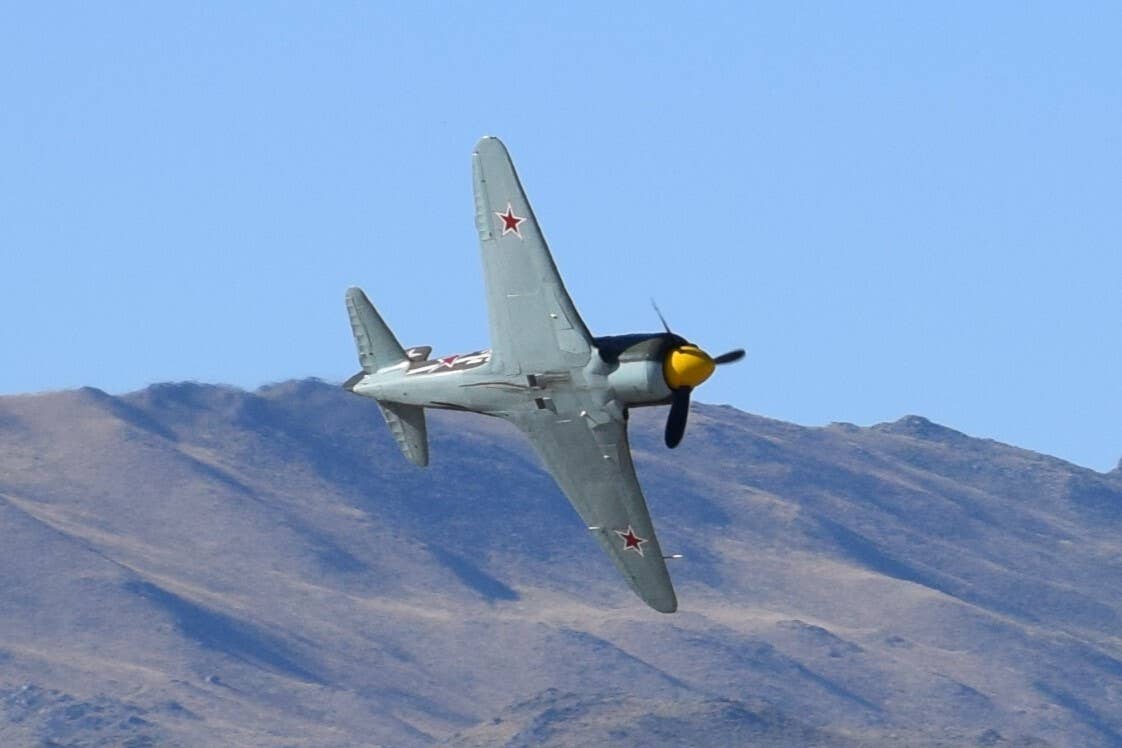Reno Races Ramp Up as Unlimited Heats Begin with ‘Miss Trinidad’ Faring Well
This article originally appeared on FLYINGmag.com. Ongoing coverage from FLYING Media Group sites during the Reno Air Races will continue this weekend. The beginning of heat races for the Unlimited Class…

The Russian Yak-3U, ‘Miss Trinidad’ [Credit: Jonathan Welsh]
This article originally appeared on FLYINGmag.com. Ongoing coverage from FLYING Media Group sites during the Reno Air Races will continue this weekend.
The beginning of heat races for the Unlimited Class on Thursday at the National Championship Air Races marked an increase in excitement for spectators, higher intensity among competitors, and more drama in the pits and on the grid.
For the final running of the races at their longtime home at Reno/Stead Airport (KRTS), FLYING is focusing on the Unlimiteds by following the Yak-3U named Miss Trinidad. The aircraft, designed in Russia during World War II, began life as an advanced trainer, like a Russian version of an AT-6 Texan. For coverage on the Sport class and other heats, see reports from KITPLANES.
Miss Trinidad owner Sam Davis, crew chief John “Dusty” Dowd and pilot John Maloney worked together with a half dozen or so volunteers to prepare the airplane for competition against a field dominated by P-51 Mustangs. It was not easy.
Engine Trouble
Today the Yak has a Pratt & Whitney R-2000 under the cowling that is more than double the size of its original engine, yet small for a radial by Reno standards. Still, as Dowd, who owns a similar racing Yak notes, the Russian aircraft is smaller and lighter than others on the grid and can remain competitive without the enormous Wright 3350 and Pratt & Whitney R-4360s that have found their way into a number of air-cooled racers.
The R-2000 seems like the ideal engine for the Yak, but it has given this team trouble. In the weeks leading up to the Reno races, problems with the oil system led to an engine replacement. As race week began the new engine still needed a bit more time for break-in and tuning. Meanwhile the pneumatic system that operates the retractable landing gear and flaps had sprang a few leaks that needed attention. There was a brief wave of confusion over the time for which the heat was scheduled, leading to fear that the team had somehow missed its cue to move to the starting line. It was a false alarm.
Ramp Drama
After being towed to the ramp to line up with the Mustangs it would compete against, Miss Trinidad continued to keep spectators in suspense. As the T-33 jet pace airplane and the Mustangs began starting their engines, the Yak’s cowling remained open and something clearly was amiss. Dowd and several helpers worked rapidly to correct what turned out to be potential hydraulic lock because of oil collecting in the lower cylinders while the aircraft was parked.
One crew member ran back to the pits to grab the proper tools for purging the excess oil. After a few more tense minutes, the crew closed the engine cowling, Maloney cranked the starter and Miss Trinidad coughed, sputtered, and finally roared, sending fragrant, oily smoke toward the crowd that gathered along the flight line to watch. Soon Maloney taxied toward the runway, performed a run-up and took off. The Mustangs followed.
Long-Awaited Race
When the pace plane released them onto the course, the pilots descended toward the guide pylon, jockeying for position before making the first left turn of the race—a classic Reno start. Maloney led into the turn with Vicky Benzing in Plum Crazy—the purple P-51 last campaigned in the 1972 Reno by Clay Lacy—right behind. They pulled away from the others, and by the time they flew past the grandstands, Maloney had begun increasing his lead, which he held to the finish. Benzing came in second. This was her first Unlimited race after many years of competing well in the Sport and Jet Classes.
Miss Trinidad was the center of attention throughout. At first, spectators wondered if she would start. Next, they might have doubted she would finish. But after she won the heat convincingly, the buzz intensified. Everyone seemed to be talking about “that Russian airplane.”
Trinidad and her crew have heats on Friday and Saturday that will sort out which teams compete in the Bronze, Silver, and Gold finals on Sunday. After qualifying at just over 358 mph, Trinidad ran about 366 mph in the first heat.
Naturally the plan is to go faster each day. Davis, Dowd, and other crew members appear to share a goal of topping a 400 mph average lap speed and making the Gold Race on Sunday, but air race folks rarely talk openly about such things. I think it is considered crass.

Subscribe to Our Newsletter
Get the latest Plane & Pilot Magazine stories delivered directly to your inbox






